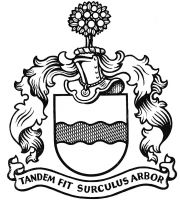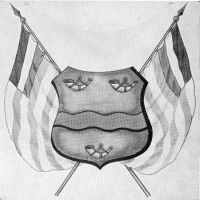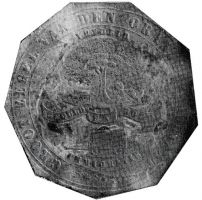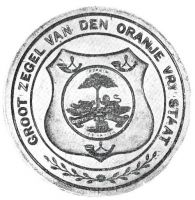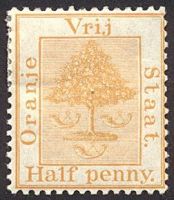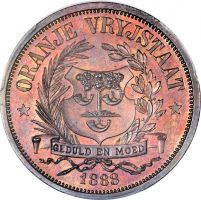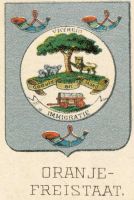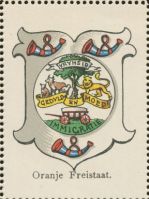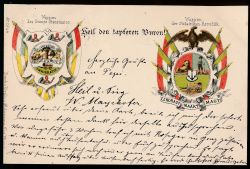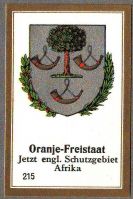Oranje Vrijstaat
|
Country: Oranje Vrijstaat
|
| Afrikaans |
Op 'n skild van silwer tussen drie blou jaghorings gemond en gesnoer van roo. 'n voorstelling van die ronde seël van die Republiek van die Oranje-Vrystaat soos aangeneem in 1856, naamlik op 'n wit skyf, in die boonste gedeelte 'n boom op 'n los grond, regs vergesel van drie skape en links van 'n natuurlike leeu wat met sy regterpoot die boom ondersteun, en in die onderste gedeelte 'n voortrekkerwa op 'n los grond, alles van natuurlike kleur; dwarsbalksgewys geplaas in `n gedrapeerde lint waarop die wapenspreuk GEDULD EN MOED voorkom, bokant die boom die woord VRYHEID en onderkant die wa die woord IMMIGRATIE; agter die skild aan twee skuinsgekruiste stokke met bal- en speerpunte, alles van goud, twee vlae van daardie Republiek, aan albei kante gedrapeer, waarvan sigbaar is sewe bane afwisselend wit en oranje, 'n kanton van drie bane, rooi, wit en blou. |
| English | On a shield Argent. between three bugle horns Azure, garnished and stringed Gules, a representation of the seal of the Orange Free State Republic as adopted in 1856. viz on a white roundel, in chief a tree on an island, between dexter, three sheep and sinister, a natural lion supporting the tree with his dexter paw, in base a Voortrekker wagon on an island all proper; on a ribbon draped fesswise, the motto GEDULD EN MOED, above the tree the word VRYHEID
and below the wagon the word IMMIGRATIE; behind the shield on two staves in saltire with ball and spear points Or, two flags of the same Republic draped on both sides, each with seven stripes visible, alternately white and orange and a canton of three stripes, red, white and blue. |
Origin/meaning
The Oranje Vrijstaat was a republic proclaimed on 23 February 1854. It succeeded the British Orange River Sovereignty, which was created in 1848 when Sir Harry Smith annexed the territory for the British. The territory had been colonised since the 1830s by the Boers moving from the Cape Colony. The Boers at that time did not form a separate republic as in the area North of the Vaal river.
The Orange River Sovereignty did not have its own arms.
The new republic had no flag, arms or seal to put on official documents, so the matter to develop national symbols was rather urgent. On 15 May 1854 the secretary of the Oranje Vrijstaat wrote to the Dutch consul whether the Dutch King William III would be willing to grant the new republic arms. Three designs were made (see below). The first showed an orange river (canting for the Orange River after which the republic was named) and as a crest an orange tree. The motto 'Tandem fit surculus arbor' means 'Ultimately the small with will become a tree'. A second design was more elaborate showing a wavy bar of red-white-blue (the Dutch flag, also part of the republican flag) and three bugle horns taken from the arms of the House of Oranje (to which the King belonged). These arms also had two savages as supporters and two flags. Finally the third version (an orange river with three bugle horns) was granted by the Dutch King, which arrived in Bloemfontein on 12 January 1856. The bar again symbolised the Orange river, the three bugles the dynasty. On each side of the arms a flag was draped. The flag was striped with 7 stripes, silver and orange, with in the corner the Dutch red-white-blue flag.
In the meanwhile the government had ordered a seal to be made in Cape Town. The matrices of the new seal arrived at the same day in Bloemfontein. This resulted in a dilemma and the Volksraad (parliament) decided to combine the two. So instead of the wavy bar, the new seal was placed between the bugles. This created a rather unheraldic coat of arms, as the seal showed a tree with sheltering under it three sheep and a lion. Under the tree stood a typical Boer wagon. Four words indicated the significance of each symbol, and were placed above the tree, between tree and wagon and below the wagon. The words were Vryheid (liberty), Geduld (patience), Moed (courage) and Immigratie (immigration).
The species of tree, unfortunately, was not defined. In 1865 the first oranges appear on the tree, on stamps for the republic. In 1891 the arms on the great seal also showed oranges. The oranges were obviously a canting symbol, but caused much debate later for the provincial arms.
Besides the above arms, sometimes small arms with a tree and three bugle horns can be found. This design was used on stamps from 1868-1902 as a simplified version of the arms. On the stamps the design is not placed in a shield though.
The Republic never issued coins, but in Germany pattern coins were made by Otto Nolte and Co in Berlin. They were probably used as a proposal to the government, but were never issued. The date is just an example date. The coin designs showed either the real arms, or the simplified version from the stamps. The government never used the small version on a shield though.
The small version as arms also appears on a medal struck in 1902 for the coronation of King Edward VII, already after the annexation, see image below. The designer probably used either the design from the stamps or the pattern coins. Why the real arms were not selected is not kownn.
In 1902 the British annexed the republic, which became the Orange River Colony.
Image gallery
The arms on a a medal from 1902 (with Transvaal and the British South Africa Company
(image © Hans Rueb)The arms in an album from around 1905
The arms in the Abdulla albums, 1929
Literature : thoe Schwartzenberg en Hohenlansberg, 1950; Brownell, 1993; Numista (on the coins), Pama, 1965
| Heraldry of the World |
| South Africa heraldry portal Civic heraldry of South Africa |
|
Contact and Support
Partners:
Your logo here ?
Contact us
© since 1995, Heraldry of the World, Ralf Hartemink 
Index of the site

